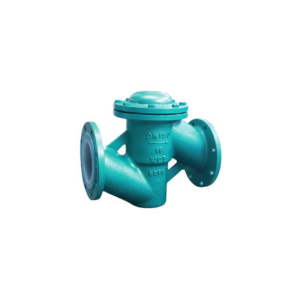Petroleum & Petrochemical Check Valve

Features
The function of this swing check valve is to allow the medium to flow in one direction only, and to stop the flow in the opposite direction. Usually, the valve works automatically. Under the action of fluid pressure flowing in one direction, the valve clack opens. When the fluid flows in the opposite direction, the adjusting tank acts on the adjusting seat by the fluid pressure and the weight of the adjusting flap to cut off the flow.
The swing check valve has a hinge mechanism, and a valve like a door rests freely on the inclined valve seat surface. In order to ensure that the valve flap can reach the proper position of the net seat surface every time, the valve flap is designed on the hinge mechanism, so that the free flap has enough swing space, and the adjustable flap comprehensively contacts the valve seat. The valve can be completely made of metal, or inlaid with leather, rubber or synthetic coverage on the metal, depending on the performance requirements. When the swing check valve is fully opened, the fluid pressure is almost unimpeded, so the pressure drop through the valve is relatively small.
• Product Standard: GB/T 12235, GB/T 12224
• Nominal Pressure: PN16-PN320
• Nominal Dimension: DN50~DN1000
• Main Material: .WCB,WCC,20CrMo,1Cr5Mo,20CrMoV,CF8,CF8M,CF3,CF3M,LCB,LCC
• Operating Temperature: - 196℃~593℃
• Applicable Intermediaries: Water, Steam, Oil, Nitric acid, Acetic acid, Strong oxidizing medium, Urea, etc.
• Connection Mode: Flange, Welding
• Transmission Mode: The valve can be opened and closed automatically by medium force, the valve can not be closed quickly by adding heavy hammer, and the valve clack can be closed slowly by adding hydraulic cylinder.
• Test Standard: GB/T 26480, GB/T 13927, JB/T 9092
Model 2

Features
The function of this lifting check valve is to allow the medium to flow in one direction only, and to stop the flow in the opposite direction. Usually, the valve works automatically. Under the action of fluid pressure flowing in one direction, the valve clack opens. When the fluid flows in the opposite direction, the adjusting tank acts on the adjusting seat by the fluid pressure and the weight of the adjusting flap to cut off the flow.
Except that the valve can be opened and lowered freely, the rest of the valve is the same as the globe valve. The fluid pressure lifts the valve clack from the sealing surface of the valve seat, and the medium return signal causes the regulating pin to fall back to the valve seat and cut off the flow. According to the conditions of use, the shunting can be an all metal structure, or it can be in the form of inlaying rubber pads or rubber rings on the word relay frame. Like the globe valve, the passage of fluid through the lifting check valve is narrow, so the pressure of lifting check valve is larger than that of swing check valve.
• Product Standard: GB/T 12235, GB/T 12224
• Nominal Pressure: PN16-PN320
• Nominal Dimension: DN50~DN600
• Main Material: .WCB,WCC,20CrMo,1Cr5Mo,20CrMoV,CF8,CF8M,CF3,CF3M,LCB,LCC
• Operating Temperature: - 196℃~593℃
• Applicable Intermediaries: Water, Steam, Oil, Nitric acid, Acetic acid, Strong oxidizing medium, Urea, etc.
• Connection Mode: Flange, Welding
• Transmission Mode: The valve can be opened and closed automatically by medium force, the valve can not be closed quickly by adding heavy hammer, and the valve clack can be closed slowly by adding hydraulic cylinder.
• Test Standard: GB/T 26480, GB/T 13927, JB/T 9092
Model 3
ANSI Check Valve

Features:
The function of this lifting check valve is to allow the medium to flow in one direction only, and to stop the flow in the opposite direction. Usually, the valve works automatically. Under the action of fluid pressure flowing in one direction, the valve clack opens. When the fluid flows in the opposite direction, the adjusting tank acts on the adjusting seat by the fluid pressure and the weight of the adjusting flap to cut off the flow.
The check valve has a hinge mechanism, and a valve like a door rests freely on the inclined valve seat surface. In order to ensure that the valve flap can reach the proper position of the net seat surface every time, the valve flap is designed on the hinge mechanism, so that the free flap has enough space, and the adjustable flap comprehensively contacts the valve seat. The valve can be completely made of metal, or inlaid with leather, rubber or synthetic coverage on the metal, depending on the performance requirements. When the check valve is fully opened, the fluid pressure is almost unimpeded, so the pressure drop through the valve is relatively small.
• Product Standard: API6D,API594,BS1868,ASME B16.34
• Nominal Pressure: CLASS150~CLASS2500
• Nominal Dimension: 2”~50”
• Main Material: A126WCB,WCC,A127WC6,WC9,C5,C12,C12A,CA15,A351CF8,CF3,CF3M,LCB,LCC
• Operating Temperature: -196℃~593℃
• Applicable Intermediaries: Water, Steam, Oil, Nitric acid, Acetic acid, Strong oxidizing medium, Urea, etc.
• Connection Mode: Flange, Wafer
• Transmission Mode: The valve can be opened and closed automatically by medium force, the valve can not be closed quickly by adding heavy hammer, and the valve clack can be closed slowly by adding hydraulic cylinder.
• Test Standard: API598, ISO5208
Product Display










